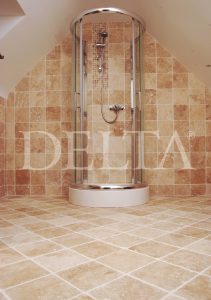What is Travertine? Travertine is a natural stone with a textured character and elegant look. It has many advantages like its low cost, but it has also disadvantages like its porous structure. It is extracted from Turkey, Iran, Mexico, and Peru. It can be used as a wall cladding and flooring.
Travertine is a natural stone which is formed by thermal springs and ore deposit. Different minerals are formed to create unique appearance of the travertine. This stone is formed by precipitation of calcium carbonate and you will see some holes which is caused by carbon dioxide evasion.
Visit for TRAVERTINE COLLECTIONS.
Travertine comes with different finishes including honed, tumbled, brushed, and polished travertines. Honed can be used in bathrooms thanks to its non-slippery character. Tumbled travertines can reflect the light and it can be used in rounded corners. Brushed ones combine the characteristics of honed and tumbled. It has a textured character and elegant look. Polished is the shiny finish with flaring look. It can be said that polished travertines look like marbles.

There are different advantages in travertines. First, we can talk about its cost. It is more cost-efficient than other stones. Another advantage is its appearance. It gives the impression that it has been there for a long time. Also, travertine doesn’t get hot when it is exposed to sunlight. This makes it an ideal choice for outdoor applications. Another benefit of travertine is the ease of shape and cut.
On the other hand, travertines have some disadvantages like its porous structure. The holes may cause the stone to wear over the time. Another drawback is its susceptibility to acids. This is why travertine wouldn’t be a best choice for kitchen applications.
Travertines can vary based on where they are extracted. This stone is extracted in Turkey, Iran, Mexico, and Peru. It is obtained in large blocks and the divided into smaller tiles.
Travertines are used as a building material for years like in Colosseum in Italy. It is also used in modern architecture in façades and wall cladding. Example for modern construction is the UCLA Medical Centre and Barcelona Pavilion.
To protect the travertine, a finish should be created, and this finish should be applied once in two years. If you apply the finished once in a year, this will protect the appearance even better. If you want to compare the durability of travertine, we can easily say that it is much more long-lasting that other stones. Its aesthetic appearance will not deteriorate easily.
If you are in Turkey or another country, we can show different types of travertines in our showroom in Istanbul, Turkey. Should you have any questions about travertine applications, please get in touch by using the contact details on our website.


